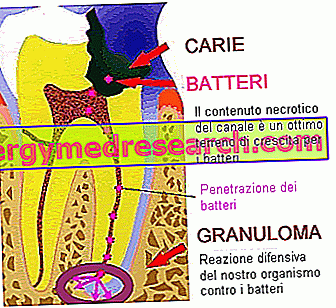Introduction
Dental infection is an invasion of pathogens (in general, bacteria) which, through dentin or radicular foramen, penetrate the tooth and multiply there, causing damage to the surrounding dental structures.

Infections of the oral cavity are very numerous and may differ in severity, origin and, clearly, type of injury. In these chapters we will review all the major dental infections, trying to highlight possible causes, symptoms and therapies to reverse the infection, remove the bacterium and prevent any relapses. Let us briefly recall that the vast majority of dental infections - from the simplest caries to the most complex dental abscess - require immediate dental intervention to avoid the most extreme and worrying solution of all: tooth extraction.
Pathogens involved
In most cases, tooth infections are bacterial in nature. In this sense, the most involved bacterial agents belong to the species Streptococcus mutans, in particular the cricetus, rattus, ferus, sobrinus strains . Even the bacterium Lactobacillus acidophilus, while not constituting the main agent triggering dental infections, can promote or support the infectious processes affecting the teeth (due to its marked ability to acidify the environment in which it is found). Let us briefly recall that Lactobacillus acidophilus produces lactic acid from the fermentation of glucose; therefore, a high charge of this bacillus reduces oral pH and, by weakening the enamel, encourages infections.
Dental infections: symptoms
It is not always so immediate to notice a dental infection in progress, especially if dental operations have not been performed in the short term.
In general, it is possible to roughly distinguish the typical symptoms of "common" dental infections from those characteristic of more serious and deeper infectious processes.
Superficial tooth infections can cause toothache, localized pain, edema (swelling) and dentinal hypersensitivity to temperature and to chewing.
Patients affected by deeper dental infections, such as abscesses, granulomas or cysts, may instead experience more serious and dangerous symptoms, such as high fever, difficulty swallowing, pain to open the mouth and, in some severe cases, even breathing difficulties . In extremely serious cases, dental infections can spread to various parts of the body to cause sepsis, dangerously endangering the patient's life.
Asymptomatic dental infections
Not all dental infections begin with precise and specific symptoms.
The granuloma - as we will see in the second part of the article - deserves an in-depth analysis: it is a typical complication of caries, dental chipping or tooth trauma, caused essentially by an infection coming from the root canal. Granuloma is an equivocal infection that, in general, does not begin with any particular symptom. The danger of this type of dental infection consists precisely in its asymptomaticity: by not treating the disorder from the earliest stages, the granuloma can remain silent for a very long time, unexpectedly evolving into fistulas or dental cysts far more dangerous than the initial infection.
We reported this example to make it clear that, despite being asymptomatic, an infection should not be neglected or even ignored.
General classification
The general classification of dental infections provides a first distinction based on the origin of the disorder:
- Periodontal origin: the infection takes place from a periodontal disease (eg pyorrhea), ie involving gums, elastic connecting fibers and supporting alveolar bone cavity.
- Pericoronal origin: the infection comes from damage done to the crown of the tooth (eg caries). The infectious process starts from the tooth enamel and eventually spreads to the dentin and dental pulp.
- Traumatic-surgical origin: the infection (eg alveolitis) is closely linked to a maleducation of an invasive dental operation, or to failure to comply with the precautionary rules after the extraction of a tooth or another dental operation.



